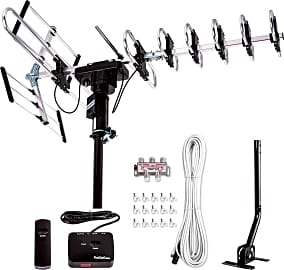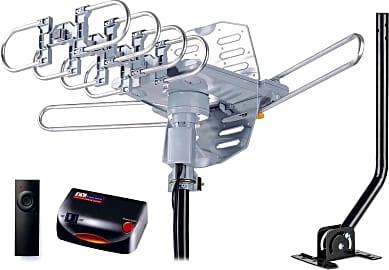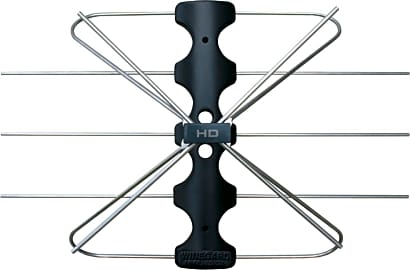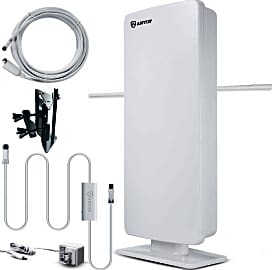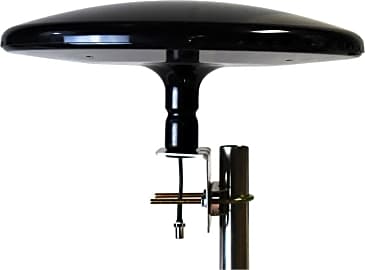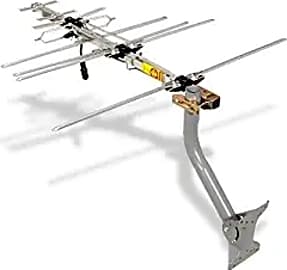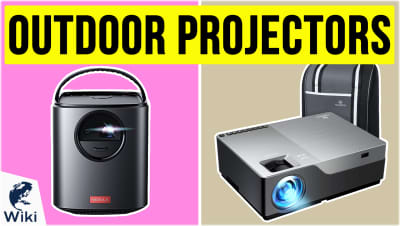The 9 Best Outdoor Antennas

This wiki has been updated 46 times since it was first published in April of 2015. Tired of paying outrageous cable or satellite television fees? Cut the cord today and channel surf for free with one of these modern outdoor antennas. They're perfect for picking up over-the-air HDTV signals as well as UHF, VHF, and FM broadcasts. We've rated some of the most cost-effective options by ease of installation, reception range, and how they'll look on or in your house. When users buy our independently chosen editorial picks, we may earn commissions to help fund the Wiki.
Editor's Notes
January 07, 2021:
A lot of these models are designed to do the same thing, which is pick up as many VHF and UHF signals as they can, though they do that with varying levels of success. One of the primary determinants of how well any model does this is its design, and it’s no coincidence that antennas can often look weird and ‘ugly’ – each rod is designed to match the wavelength of a particular set of radio stations it’s trying to pick up. Nowadays, outdoor antennas are designed with longer rods for VHF signals as well as shorter rods for UHF bands, which are more commonly broadcasted on nowadays. With that being said, in order to give you a range of options, I wanted to include models that, at very least, were structurally different from each other, as a lot of antennae on the market are carbon copies of each other.
For example, a more omnidirectional antenna like the Channel Master CM-4220HD may give you a broader range of channels over a directional (pointier) antenna like the RCA Yagi or PingBingDing HDTV, though the latter should give you better reception of a narrow frequency band, as well as a longer range, depending on where it’s pointed at. Of course, these differences are typically negligible, but directional antennas nowadays usually offer remote control to allow you to rotate and orient the receiver in the direction you want.
You’re best off using an omni-directional antenna in urban environments, or in rural areas with lots of mountains, forests and other obstacles blocking your antenna’s line of sight to the cell tower, or you’re in a moving vehicle. While some of the smaller encased options like the Antop AT-400BV do offer more flexibility over roof-mounted antennas - aside from being ‘easier on the eyes’ – they’re akin to indoor antennas, as they may not give you the best VHF reception or longest range, though they will be slightly better than indoor options.
September 06, 2019:
People are often surprised at how good the picture quality can be from standard OTA broadcasts, but you need a good antenna to take advantage of them. Traditional antennas generally aren't the prettiest pieces of hardware, but even the bulky ones like the Antennas Direct DB8-E can be very effective; in fact, that one's especially nice because of its dual-aiming feature, but it really is pretty ugly. Standard yagi-style models, like the 1ByOne and RCA, are very powerful, but to change between broadcast stations and pick up channels in different directions, you'll have to manually aim the unit. That's one of the reasons we like the PingBingDing so much, as it's wirelessly controlled and easy to rotate, which also has the function of making initial setup much, much easier.
If you live a little closer to the broadcast location and want something that looks a little cleaner, the Antops and the Winegard Flatwave are particularly sleek compared to most. In the middle of those two extremes are the Winegard FreeVision and Antennas Direct ClearStream, which balance decent looks and a long range quite well.
Finally, if you're really focused on ditching the cord and helping out your budget, our guide to budget TVs and cord-cutting entertainment devices may both be able to help.
What Is An Outdoor Antenna?
Most are very simple to install and will have you picking up local stations in no time.
Have you had enough of paying outrageous prices for cable or satellite just so you can watch your favorite sports or catch a popular prime time show? We feel your pain. It seems that so many of us forget that there is a simpler and cheaper way to watch the television we want without promising our firstborn children.
The outdoor antenna is one solution to all of these problems. It will save you money in the long run because you pay one time to pick up signals from stations that broadcast locally. You're not stuck in a binding contract, you don't have to make any irritating monthly payments, and you don't have to promise your love, loyalty, and future friend referrals to the emperor (cable company).
Some current outdoor antennas can be used both outdoors and indoors, but there are several that cannot be used with TVs made before the last decade. Most are very simple to install and will have you picking up local stations in no time. Depending on where you live, though, you might get a weak signal from the wrong antenna. Many are made to withstand all types of weather and are just as reliable as a cable antenna or satellite dish. You can even use some outdoor antennas to pick up local radio signals.
Many antenna's are currently sold with HD capabilities. If the channel you are watching has upgraded to HD, then the outdoor antenna you buy will most likely be compatible. To receive the proper signal, your antenna will have to be pointed in the direction of the nearest signal tower. You can spin in circles until you figure it out, or you can do some quick research about your local area before you buy and find out what kind of range you need on your new antenna. We recommend the latter.
What Do I Need To Know Before I Buy?
Perhaps you have found yourself in the midst of a conundrum. You have voiced your consideration for purchasing a high quality outdoor antenna but have been told that an indoor antenna will work just as well.
"Plus, it's cheaper!" the critics say.
So, should you bend to the will of the naysayers and purchase an indoor antenna, or go with your gut and your original plan and purchase one of the outdoor antennas you have been eyeing?
Depending on your local station selection, you will likely get to watch most of the popular network television shows and a variety of local and professional sports casts.
The answer is actually pretty simple. If you live within close proximity (usually thirty miles or less) of the nearest broadcast towers, an indoor antenna will pick up a few local channels.
However, if you live in a rural area or live a significant distance from the nearest broadcast tower, you will want to go with the outdoor antenna. They generally have a longer range and will pick up clearer signals and more channels.
If you are an avid television viewer and hate paying for cable or satellite, the outdoor antenna is clearly the way to go.
You're obviously not going to get the premium channel packages and 400 different channels to choose from that you would get from a cable or satellite subscription, but you will get a range of local channels and a clear, crisp signal.
Digital, outdoor antennas are the way to go for both standard definition and high definition viewing. Depending on your local station selection, you will likely get to watch most of the popular network television shows and a variety of local and professional sports casts.
A Brief History Of The Outdoor Antenna
Do you remember a time before television was a common part of daily life? Neither do we. Within the past decade technology has advanced to the point that we can take television with us wherever we go. While it seems to many of us that this has always been the way of things, it has only been within the past seventy years that television has been such an integral part of American life.
Middlemark's invention made television available to a wide audience allowing for a better signal in many areas of the United States.
In 1953, Marvin Middlemark invented the dipole antenna, also known as Rabbit Ears. Many consider this invention to be the reason that television viewing and popularity soared in 1950s and 1960s. Middlemark's invention made television available to a wide audience allowing for a better signal in many areas of the United States.
Rabbit Ears enhanced the signal reception people were already getting on their televisions, and sometimes they worked to pick up the signals that the built-in television antenna could not. Without rabbit ear antennas, many households would not have been able to watch television at all. This invention revolutionized the television industry and brought TV into nearly every household in the United States.
In fact, early televisions could only operate on antenna signals. Viewers didn't pay for cable plans for several years, and even then, they used clunky cable boxes. In later years, cable and satellite services were developed where households could and can have access to multiple channels at their fingertips at any time. Some subscription services provide hundreds of channel options.
Despite the options available for television, many people are deciding to cut costs. That's why indoor and outdoor antennas (including the traditional rabbit ears) are rising in popularity once more and being used in multiple households across the United States.



